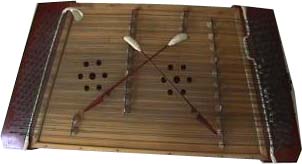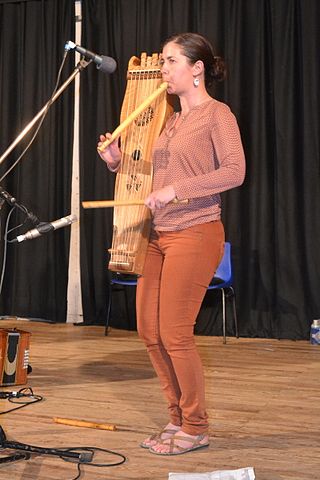
The guitar is a stringed musical instrument that is usually fretted and typically has six or twelve strings. It is usually held flat against the player's body and played by strumming or plucking the strings with the dominant hand, while simultaneously pressing selected strings against frets with the fingers of the opposite hand. A guitar pick may also be used to strike the strings. The sound of the guitar is projected either acoustically, by means of a resonant hollow chamber on the guitar, or amplified by an electronic pickup and an amplifier.

The hammered dulcimer is a percussion-stringed instrument which consists of strings typically stretched over a trapezoidal resonant sound board. The hammered dulcimer is set before the musician, who in more traditional styles may sit cross-legged on the floor, or in a more modern style may stand or sit at a wooden support with legs. The player holds a small spoon-shaped mallet hammer in each hand to strike the strings. The Graeco-Roman word dulcimer derives from the Latin dulcis (sweet) and the Greek melos (song). The dulcimer, in which the strings are beaten with small hammers, originated from the psaltery, in which the strings are plucked.

In musical instrument classification, string instruments or chordophones, are musical instruments that produce sound from vibrating strings when a performer plays or sounds the strings in some manner.

Zithers are a class of stringed instruments. Historically, it could be any instrument of the psaltery family. In modern terminology, it is more specifically an instrument consisting of many strings stretched across a thin, flat body, the topic of this article.

An electric piano is a musical instrument that has a piano-style musical keyboard, where sound is produced by means of mechanical hammers striking metal strings or reeds or wire tines, which leads to vibrations which are then converted into electrical signals by pickups. The pickups are connected to an instrument amplifier and loudspeaker to reinforce the sound sufficiently for the performer and audience to hear. Unlike a synthesizer, the electric piano is not an electronic instrument. Instead, it is an electro-mechanical instrument. Some early electric pianos used lengths of wire to produce the tone, like a traditional piano. Smaller electric pianos used short slivers of steel to produce the tone. The earliest electric pianos were invented in the late 1920s; the 1929 Neo-Bechstein electric grand piano was among the first. Probably the earliest stringless model was Lloyd Loar's Vivi-Tone Clavier. A few other noteworthy producers of electric pianos include Baldwin Piano and Organ Company, and the Wurlitzer Company.

The tsymbaly is the Ukrainian version of the hammer dulcimer. It is a chordophone made up of a trapezoidal box with metal strings strung across it. The tsymbaly is played by striking two beaters against the strings.

The cimbalom, cimbal or concert cimbalom is a type of chordophone composed of a large, trapezoidal box on legs with metal strings stretched across its top and a damping pedal underneath. It was designed and created by V. Josef Schunda in 1874 in Budapest, based on his modifications to the existing Hammered dulcimer instruments which were already present in Central and Eastern Europe.

The Appalachian dulcimer is a fretted string instrument of the zither family, typically with three or four strings, originally played in the Appalachian region of the United States. The body extends the length of the fingerboard, and its fretting is generally diatonic.

The trapezoidal yangqin is a Chinese hammered dulcimer, likely derived from the Iranian santur or the European dulcimer. It used to be written with the characters 洋琴, but over time the first character changed to 揚, which means "acclaimed". It is also spelled yang ch'in. Hammered dulcimers of various types are now very popular not only in China, but also Eastern Europe, the Middle East, India, Iran, and Pakistan. The instruments are also sometimes known by the names "santoor" and "cymbalom". This instrument had an influence on the Thai classical instrument, known as Khim (ขิม).

The Marxophone is a fretless zither played via a system of metal hammers. It features two octaves of double melody strings in the key of C major, and four sets of chord strings. Sounding somewhat like a mandolin, the Marxophone's timbre is also reminiscent of various types of hammered dulcimers.

The ektara is a one-stringed musical instrument used in the traditional music of the Indian subcontinent, and used in modern-day music of Bangladesh, India, and Pakistan.
An acoustic guitar is a musical instrument in the string family. When a string is plucked, its vibration is transmitted from the bridge, resonating throughout the top of the guitar. It is also transmitted to the side and back of the instrument, resonating through the air in the body, and producing sound from the sound hole. While the original, general term for this stringed instrument is guitar, the retronym 'acoustic guitar' – often used to indicate the steel stringed model – distinguishes it from an electric guitar, which relies on electronic amplification. Typically, a guitar's body is a sound box, of which the top side serves as a sound board that enhances the vibration sounds of the strings. In standard tuning the guitar's six strings are tuned (low to high) E2 A2 D3 G3 B3 E4.
In music, a bowhammer is a device used when playing a cymbalum to strike, pull across or pick the strings in order to make them vibrate and emit sound. It was devised to replace the mallets that were traditionally used to play the cymbalum. Unlike mallets, which almost exclusively are used for striking, the bowhammer allows for greater versatility, "expanding the sonic and expressive scope of an ancient instrument."

The string drum or Tambourin de Béarn is a long rectangular box zither beaten with a mallet. It is paired with a one-handed flute with three finger holes, similar to a pipe and tabor. It has also been called tambourin de Gascogne, tambourin à cordes in Catalan, Pyrenean string drum, ttun-ttun in Basque, salmo in Spanish, and chicotén in Aragonese. It was known in the middle ages as the choron or chorus.

The épinette des Vosges is a traditional plucked-string instrument of the zither family, whose use was confined to two areas in the Vosges mountains of France approximately 50 km apart: around Val-d'Ajol and around Gérardmer.

Guitar picking is a group of hand and finger techniques a guitarist uses to set guitar strings in motion to produce audible notes. These techniques involve plucking, strumming, brushing, etc. Picking can be done with:
Damping is a technique in music for altering the sound of a musical instrument by reducing oscillations or vibrations. Damping methods are used for a number of instruments.

The santur, is a hammered dulcimer of Iranian origins.

The Indian santoor instrument is a trapezoid-shaped hammered dulcimer, and a variation of the Iranian santur. The instrument is generally made of walnut and has 25 bridges. Each bridge has 4 strings, making for a total of 100 strings. It is a traditional instrument in Jammu and Kashmir, and dates back to ancient times. It was called Shatha Tantri Veena in ancient Sanskrit texts.

Music technology is the study or the use of any device, mechanism, machine or tool by a musician or composer to make or perform music; to compose, notate, playback or record songs or pieces; or to analyze or edit music.
















